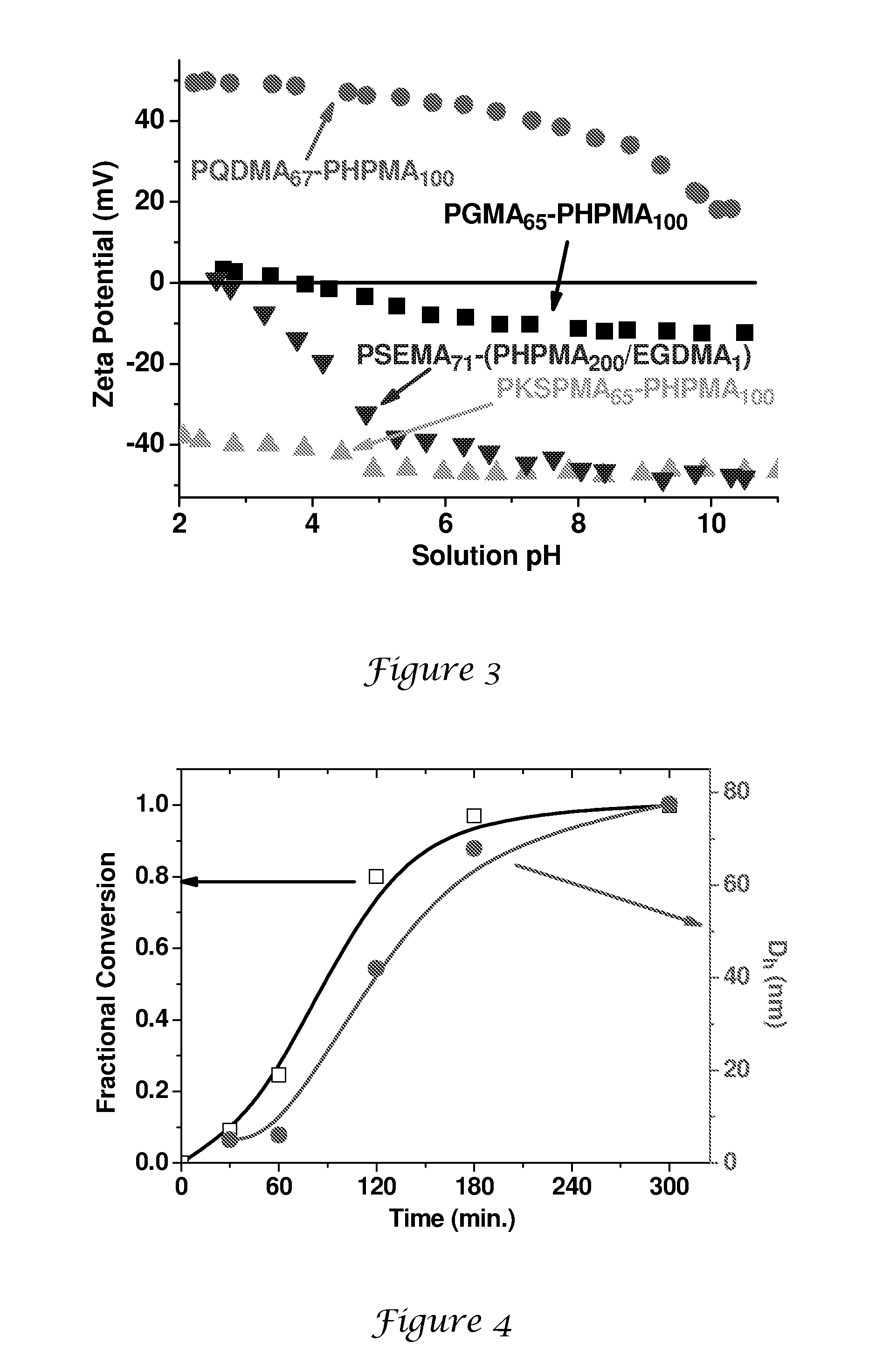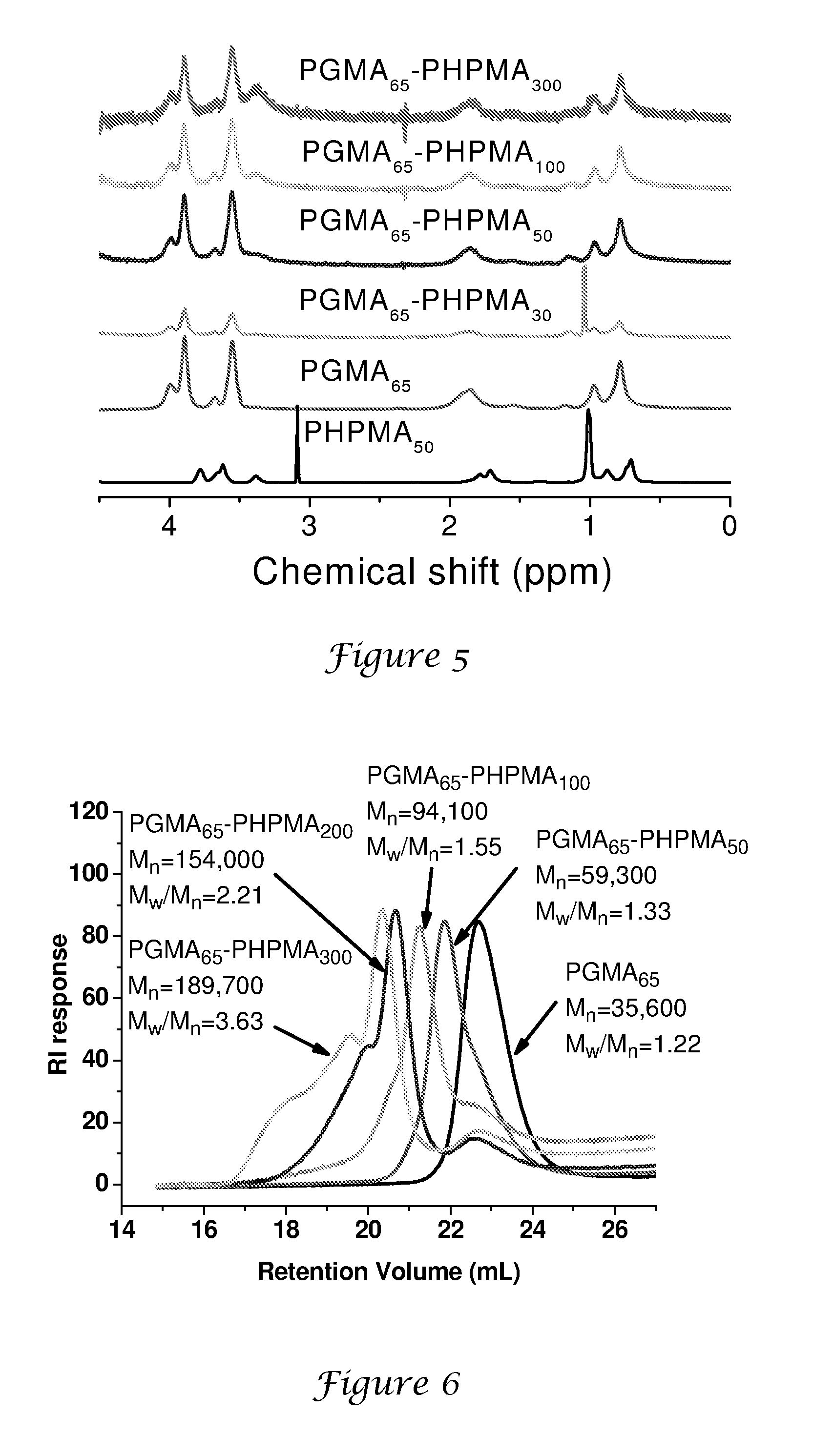Polymer Synthesis
a technology of polymer and synthesis, applied in the direction of flotation, solid separation, coatings, etc., can solve the problems of reducing film quality, poor adhesion, and compromising the quality of waterborne coatings
- Summary
- Abstract
- Description
- Claims
- Application Information
AI Technical Summary
Benefits of technology
Problems solved by technology
Method used
Image
Examples
example 1
General Protocol for the RAFT Polymerisation of GMA
[0146]4,4′-Azobis(4-cyanopentanoic acid) (0.0309 g, 0.083 mmol), CTP (0.1224 g, 0.417 mmol) and GMA (4.00 g, 25 mmol) were added to a mixture of deionised water (8.0 g) and dioxane (8.0 g) in an ampoule. The solution was stirred until all the CTP had dissolved. The ampoule was sparged with nitrogen for approximately 30 min. and then placed in a pre-heated oil bath at 70° C. The polymerisation was terminated after 4 h by cooling the reaction vessel in an ice bath. The crude PGMA homopolymer was purified by dialysis against water and isolated by lyophilisation. Yield=3.9 g (98%) and Mn=36,200; Mw / Mn=1.22, as judged by DMF GPC vs. poly(methyl methacrylate) standards. The actual degree of polymerisation of this macroCTA is around 65 (hence it is denoted ‘PGMA65’) as judged by 1H NMR, which indicates that the CTA efficiency is around 90%.
example 2
PGMA65-PHPMA300 Latex Syntheses
[0147]A general protocol for the synthesis of PGMA65-PHPMAx nanolatexes via RAFT at 10% solids is exemplified as follows for PGMA65-PHPMA300. 4,4′-Azobis(4-cyanopentanoic acid) initiator (0.0014 g, 0.0038 mmol), PGMA65 macroCTA (0.150 g) and HPMA (0.810 g, 5.6 mmol; target DP=300; CTA / initiator molar ratio=5:1) were dissolved in deionised water (8.64 g). This solution was stirred at around 20° C. until both reagents had dissolved (solution pH around 7.0). After sparging with nitrogen for 30 min, the reaction was allowed to proceed at 70° C. with continuous stirring for 24 h. The polymerisation was quenched by cooling the reaction vessel in an ice bath. DLS analysis indicates a mean particle diameter of around 105 nm (PDI=0.003).
example 3
‘20% Solids’ Synthesis of a PGMA65-PHPMA100 Nanolatex
[0148]4,4′-Azobis(4-cyanopentanoic acid) initiator (0.0014 g, 0.0038 mmol), PGMA65 macroCTA (0.150 g) and HPMA (0.27 g, 1.9 mmol; target DP=100; CTA / initiator molar ratio=5:1) were dissolved in deionised water (1.68 g). The solution was stirred at 20° C. until all the solids had fully dissolved (N.B. the HPMA monomer is not quite fully miscible under these conditions). After sparging with nitrogen for 30 min, the polymerisation was allowed to proceed at 70° C. After 30 min the solution becomes transparent due to partial consumption of the HPMA monomer. The reaction was quenched after 24 h by cooling the reaction vessel in an ice bath. DLS analysis indicates a mean particle diameter of around 73 nm (PDI=0.11).
PUM
| Property | Measurement | Unit |
|---|---|---|
| mean diameter | aaaaa | aaaaa |
| mean diameter | aaaaa | aaaaa |
| mean diameter | aaaaa | aaaaa |
Abstract
Description
Claims
Application Information
 Login to View More
Login to View More - R&D
- Intellectual Property
- Life Sciences
- Materials
- Tech Scout
- Unparalleled Data Quality
- Higher Quality Content
- 60% Fewer Hallucinations
Browse by: Latest US Patents, China's latest patents, Technical Efficacy Thesaurus, Application Domain, Technology Topic, Popular Technical Reports.
© 2025 PatSnap. All rights reserved.Legal|Privacy policy|Modern Slavery Act Transparency Statement|Sitemap|About US| Contact US: help@patsnap.com



